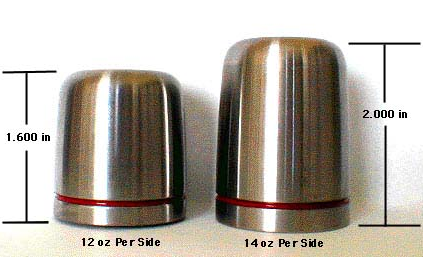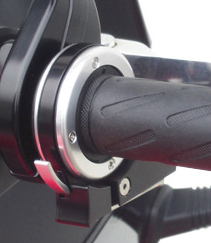Keep in mind that the following is written from a mechanically challenged point and I could miss some tips that experienced pros use.
What you might need from the store before starting...
Plugs
Socket and wrench set
Needle nose pliers
Shop rags
Things you may have around the house...
Towel or soft blanket
Tape
A person with small hands (trust me, you really need one of these)
The tool kit from under your seat
In the beginning...of changing spark plugs
Remove the seat, pretty much assuming everyone knows how.
Remove the bolts at the rear of the gas tank using a 10mm socket and wrench. Remove the little rubber washers and store them for safe keeping. The washers have a tendency to fall down under the bike when moving the tank around. Use the battery box cover for a convenient place to hold bolts and small tools while working on the Bandit.
Turn the fuel valve switch to On. Bandits have a vacuum activated fuel delivery system so you do not need to remove the gas from the tank. Remove the phillips head screw holding the fuel valve switch in place.
Working under the tank to remove the hoses represents a significant achievement for normal sized hands. The service manual shows some parts already moved out of the way to get to the hoses. In this case, I felt a blow to my trust in whomever makes service manuals. I expect service manual writers to remember that the people who likely need a service manual require large full detail photographs to go along with the horridly detailed instructions. A link to a full HD video would be nice as well. And a 1-800 number to call in case I get stuck.
Remove the vacuum hose. You may need to use some needle nose pliers for gently tugging on the hose. Wrap some tape around the front of the pliers to avoid the groves damaging the rubber hose.
 |
| Pliers taped with orange electrical tape. I like my tape colorful. I probably got it from one of Vintage Electric's shelves. |
Use a gentle pulling with constant pressure to slowly remove the hose. You will avoid tearing the hose if you have a bit of patience in this step.
 |
| Vacuum hose next to the PRI position on the petcock |
 |
| Fuel line with clamp under and to the rear of the petcock |
On the right side, close to the rear of the tank, remove the water drain hose and fuel tank breather hose. Fuel tanks have snorkels, who knew? I digress...Use the same gently pulling with constant pressure that I mentioned about the other hoses. If your hands are small enough you may avoid using the pliers.
 |
| Breather and Water Drain hoses |
 |
| Fuel Level Gauge Lead Wire Coupler on the Right |
 |
| Tank chillaxin on the comforter and an empty oil container |
Note that the above work seems like a lot, but it only took about thirty minutes on my first try. I've read that some people can remove the plugs without removing the tank. After seeing how tight the area is even after removing the tank, I am now in awe of those people who have the dexterity to get the plugs out without removing the tank. I am thinking either freakishly long fingers or some ability to manipulate physics of the known universe.
Pull the spark plug tool and the 17mm / 14mm wrench out of the stock tool kit that comes with the Bandit. The length of the plug tool and the rubber grommet helps a bunch when removing the plugs. The wrench is a little short but it works for pulling plugs from 2 and 4. My socket wrench would not fit.
 |
| 17mm / 14mm wrench and spark plug socket |
Insert the plug tool from the kit and remove the plugs. The plug tool can be a bit of a stubborn child when working in tight spaces. If you look under the frame towards the front of the bike, you will notice a little space above each plug hole. In the especially tight areas, put the tool in perpendicular to the ground, slide the top a little forward and up into the space, then down into the plug hole.
 |
| An area above the cylinder head that you can slip the spark plug tool up into |
Push it down a bit until it's snug then remove the plug using either a socket / wrench combination, or the 17mm / 14mm wrench. I suggest loosening the plug then using your fingers to turn the plug removal tool. It's easy to cross thread the plug socket when using too much pressure on the wrench.
 |
| Spark plug removal tool |
Once you have all the plugs removed, check them for a significant amount of gunk. A little carbon or soot on the ends, no big deal. If your plug looks like it has some mystery gunk that potentially could qualify for membership into the "new life-form of the month club," you need to look into some extensive service. It's possible that your cylinder walls, o-rings, pistons, or seals have damage. As a previous driver of a motorcycle that doubled as a mosquito fogger (Honda Hawk burned as much oil as gas), I am familiar with the massive pain damaged cylinders or pistons represent. If you are in town, take it by RPM Motorcycles. The owner drives a Bandit and is familiar with the quirks and tantrums that the Bandit's like to display.
Gap the new plugs to .024 - .028 inches.
Begin installing the new plugs, working from the inside out on each side of the Bandit. Use your fingers to tighten down the plugs initially. Avoid cross threading the plug holes, a major pain to fix and will require taking the cylinder heads off.
Getting the plug wires back into place takes some dexterity. I am beginning to wonder if engineers have extremely long fingers or tiny hands. My knuckles currently threaten striking if working conditions do not improve.
Time to put the tank back on...
You may want to do some cleaning under the tank area while you have the ability. As you can see from my pictures, my Bandit does not wash behind the ears very well.
It's time to get the small handed person tool out. In my case, I used my superhero wife. Actually she is the model that all superheroes aspire to but fail miserably. I digress...but I love bragging about my wife. Makes me smile...
 |
| My wife's hand, I probably should have given her the gloves |
I held the tank while my wife reached her hands under and attached the vacuum line, fuel hose, fuel hose clamp, and fuel gauge lead wire. Check the fuel line to make sure it's not pinched or crimped.
Let the tank rest close to the frame, propping it up with a piece of rubber or rubber handled screw driver works. Getting the water drain and breather hose back on requires the tank sitting almost flush with the frame. Install the two hoses then replace the rubber washers, grommets, and bolts at the back of the tank.
 |
| I scratched my frame...Grrr. |
Start up the Bandit. Mine was almost scary how fast it caught and started rumbling.
All done, clean up your mess before the neighbors or your wife start giving you looks. Or your one year old boy reaches for your greasy tools and tries to eat them.






















